How to create a heavy tank EC-2
It is worth noting that 1943 year was very "fruitful" to create heavy tanks. Thus, in summer and autumn, armored vehicles of the types EC-1 and KV-85 were adopted and the EC-2 became the latest model of this class of equipment developed that year. In parallel with the creation of new technology, engineers were engaged in the development of weapons issues for promising heavy tanks. It was these works that ultimately led to the emergence of the EC-2 project.
In April, a test shelling of the captured Tiger tank was carried out using 43 using several domestic guns. The most effective in these tests showed anti-aircraft gun 52-K caliber 85 mm. According to the results of these checks, the Central Artillery Design Bureau and the Design Bureau of Plant No. XXUMX were assigned the task of developing new tank guns based on anti-aircraft 9-K ballistics.
The result of two new projects was the creation of C-31 and D-5T cannons. In the future, these guns were installed on prototype tanks used in the tests. According to the test results, the military chose two versions of the proposed equipment, which later entered into service under the names KV-85 and EC-85 (EC-1). In the fall of the 43, these machines went to the front, but it soon became clear that the used weapon does not allow you to effectively deal with the modern armored vehicles of the enemy, and the outcome of the battle depends primarily on the skills of the crew.
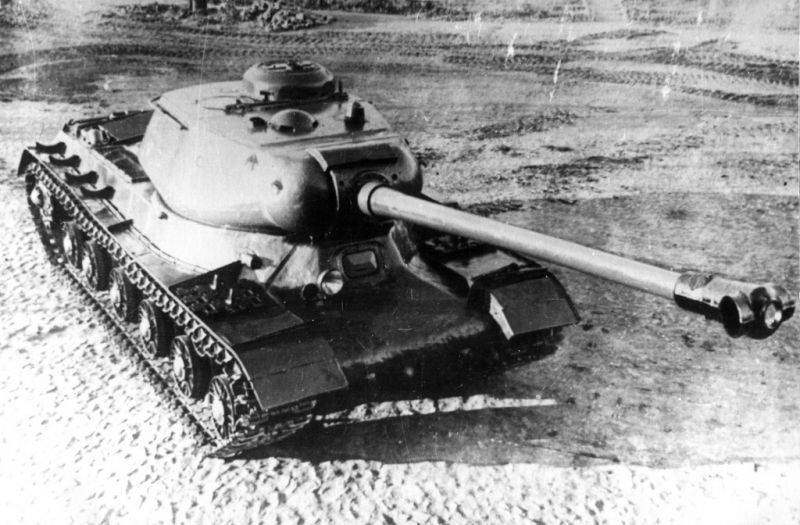
The "240 Object" is being tested. The first T-shaped muzzle brake is clearly visible. Photo Warspot.ru
Back at the end of the summer of 1943, Soviet specialists were actively engaged in analyzing the results of the Battle of Kursk. Director and Chief Designer of the Experimental Plant No.100 J.I. Kotin, as well as specialists of KB Plant No. XXUMX, almost simultaneously came to the same conclusions. They noticed that during the fighting on the Kursk Bulge, the most effective means of fighting the enemy Tigers, not to mention the previous models with less powerful defenses, were 9-mm guns of the 122 / 1931 type, also known as A.- 37. Soon, Plant No.19 developed the D-9 tank gun, which was supposed to have ballistics of the A-2 cannon on the gun of the M-19 howitzer. After some improvements, such a gun could become a weapon of promising heavy tanks and successfully fight with similar enemy equipment.
After some negotiations, the specialists of the two design offices came to the conclusion that it was possible in principle to use the D-2 cannon or a similar weapon as part of the weapons of a prospective heavy tank. It was decided to create a new version of the gun based on the A-19, in which the cradle and anti-recoil devices from the U-11 gun project should have been used. In addition, it was necessary to equip the barrel with a muzzle brake, which was supposed to reduce the load on the tank design. In the future, these ideas have undergone some changes, but still led to the appearance of promising tank guns.
After the transfer of the necessary documentation, the designers of Plant No. XXUMX under the supervision of F.F. Petrova prepared a draft design of the updated turret of the EC-9 tank with the new 85-mm gun. Soon Kotin presented a new draft to the leadership of the country and the tank industry. The project was approved, after which the experts began to prepare a complete set of design documentation.
According to reports, the completion of the project was to improve the design of the tower with weapons, as well as in some modifications of the existing building. As a basis for a promising heavy tank, it was decided to use the existing “237 Object”. Earlier, in the summer of the 43, this machine was used as a prototype for one of the variants of the new tank armed with an 85-mm cannon. In the course of creating the prototype "Object 237", the existing components and assemblies were actively used, and in addition, some new ideas were applied.
At the design stage of the version of the IS tank with an 85 mm caliber gun, it became clear that the existing hull design does not allow the use of such weapons. While maintaining the shoulder strap with a diameter of 1535 mm, the installation of 85-mm guns led to a sharp deterioration in the working conditions of the crew. For this reason, it was decided to increase the shoulder strap to 1800 mm, for which the body had to be lengthened. The length of the fighting compartment increased by 420 mm, which required adding an additional (sixth) pair of road wheels to the chassis. Also, the "237 Object" received an updated tower for an increased diameter of the shoulder strap. As a result of such modifications, the combat mass of the prototype grew to 44 t with negative consequences for mobility and some other characteristics.
To speed up the work on the new project of a heavy tank with an 122-mm gun, it was decided to build a prototype of this machine based on the “237 Object”. In the course of construction, the existing gun was dismantled from the prototype, in place of which a new one, designed by Plant No. XXUMX, was installed. In this configuration, the heavy tank received the factory designation "Object 9" and went to the test.
It is noteworthy that the tests of a promising heavy tank started only a few weeks after being put into service. Already on October 31, the State Defense Committee, having familiarized itself with the proposed project, decided to put into service the new heavy tank “IS” with the 122-mm gun. The same decree asked the development of a tank version of the A-19 gun, which should have been assembled by November 11 and passed to tests by the end of the month. The first version of the gun was supposed to have a piston valve. In 1944, the series planned to launch a new version of the gun with a wedge gate.
The construction of the new prototype was carried out at the experimental plant No. XXUMX. For the construction of the tank were made some new components. In addition, Plant No. XXNX specialists manufactured a prototype of a promising tank gun. The developers of the guns were a little out of date and completed the assembly of the “A-100 Tank” one day after the deadline. The transferred gun was soon installed on the updated fastenings of the existing tower.
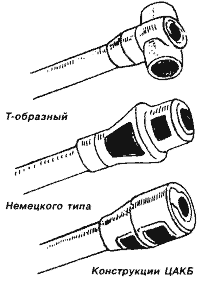
Three versions of muzzle brakes used on the 240 Object / IS-2 tanks. Figure Armor.kiev.ua
The tank version of the A-19 cannon was created on the basis of the previously developed D-2 and D-5 guns. The trunk was borrowed from the first one, the guide part of which was ground to the required diameter. The D-5T gun, in turn, “shared” the cradle and wheel chocks. At the request of the developers of the tank, the new gun was to be equipped with a muzzle brake, reducing the load on the design of the shoulder strap and armored hull. This T-architecture product was borrowed from the existing version of the D-2 project. The finished gun was designated D-25T.
After minor modifications of the existing tower, the former “237 Object” received a new D-25T type gun. In this form, the new "Object 240" in October came to the test. The test car was delivered to the Chebarkul landfill, where running and fire tests were carried out. Test runs on the landfill allowed us to establish the exact characteristics of the new machine, as well as to identify the last remaining shortcomings. In this case, the first tests were passed without any problems, which was facilitated by the use of the already tested and tested chassis.
After testing at the test site near Chelyabinsk, an experienced "240 Object" was delivered to one of the test sites near Moscow, where additional tests were carried out. At this stage of testing, some tests were performed in the presence of military leaders. In particular, under Marshal K.E. Voroshilov an unpleasant incident occurred.
During the tests in the Moscow region, it turned out that the first version of the muzzle brake of the T-shaped structure was not strong enough. During one of the test shots, this device could not withstand the pressure of powder gases and exploded, scattering debris in different directions. According to some sources, during this incident, one of the fragments of the muzzle brake nearly killed Voroshilov, who was present at the shooting. However, in other sources and documents like story No mention is made of this, which makes it a rumor or legend
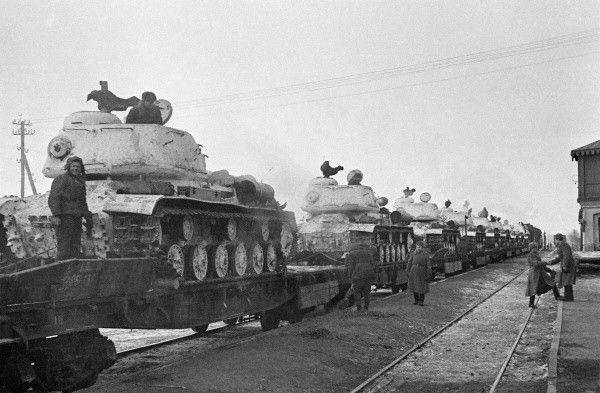
Serial IC-2 going to the front. Winter 1945 g. Photo by Wikimedia Commons
It should be noted that the shot that led to the destruction of the muzzle brake, however, ended with a successful defeat of the training target. As a target for these tests, the captured tank "Panther" was used, which had already managed to "catch" many shells of various calibers. The target tank turret was deployed to the right, due to which the 122-mm projectile hit had to be in the side sheet. An armor-piercing shell pierced the side of the tower and hit the opposite sheet, tearing it along the weld.
According to the results of these tests, the D-25T gun received a new so-called muzzle brake. German sample. It had an anteriorly expanding posterior chamber and a cylindrical anterior chamber. On the side walls of both chambers there were holes for discharge of powder gases. Muzzle brakes of a similar design were actively used by German designers, which was the reason for the appearance of the corresponding name. In the updated configuration with the German muzzle brake, the gun went into series and was released over the next few months.
In the fall of 1943, the Chelyabinsk Kirov Plant launched mass production of several new heavy tanks. So, in November, the first serial KV-85 came out of the enterprise’s workshops. The following month, the launch of tanks "Object 240", by which time received the designation of EC-2. In addition, during the first months this car was often referred to as the EC-122, according to the caliber of the gun.
The use of the new 122 mm tank guns provided high firepower and the ability to effectively defeat the enemy’s medium and heavy tanks. For this reason, the command ordered to increase the release of new EC-2, including through the construction of KV-85. Because of this, in January 1944 of the year in Chelyabinsk collected the last four dozen KV machines, after which their production was stopped. In the future, the army received only EC-2 / 122. In December, the 43 plant built 35 new tanks. The same number of armored vehicles released in the first month of 1944. In the future, production volumes grew steadily.
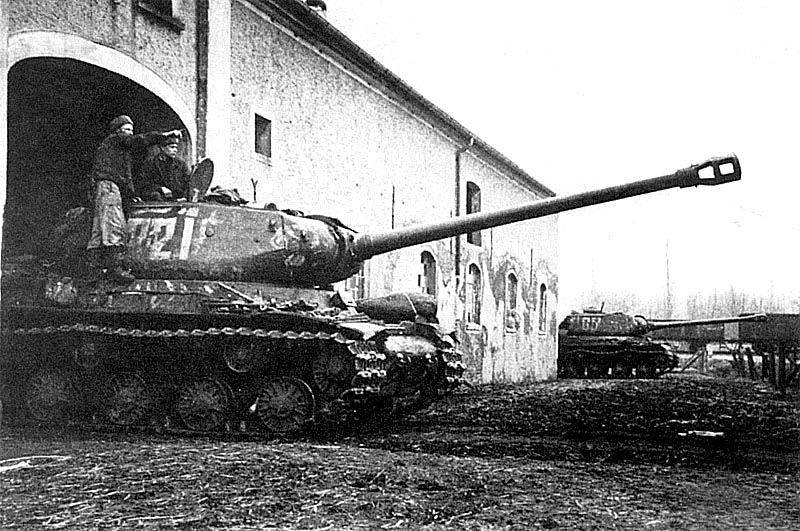
Tanks EC-2 in Germany, spring 1945. Photo Aviarmor.net
Despite the completion of the design work and the beginning of serial production, the designers continued to develop the tank and its weapons. So, already at the beginning of 1944, the first D-25T guns came off the conveyor with a new semi-automatic wedge gate, the development of which was given by the resolution of October 31. Introduced innovations allowed to slightly increase the rate of fire. A piston-bolt gun could fire no more than a 1-1,5 shot per minute, while a wedge one allowed this parameter to be adjusted to 1,5-2 shots per minute. In addition, the new guns received a two-chamber muzzle brake, developed by the Central Artillery Design Bureau.
The emergence of heavy tanks with 122 caliber guns mm has significantly increased the potential of armored forces. The new gun allowed the EC-2 vehicles to effectively deal with German heavy tanks at fairly long distances. However, shortly after the start of operation of the new technology, the first complaints began to be received by the troops. Tankers approved the use of a more powerful gun, but expressed complaints about the relatively low rate of fire. In addition, he left much to be desired ammunition: in the fighting compartment of the EC-122 only 28 was able to place separate loading shots.
There were also some problems with the power of the gun. In practice, the sharp-headed armor-piercing projectile BR-471 could penetrate the frontal armor of the Panther tank from a distance of no more than 700 m. It also turned out that the shelling of tanks with fragmentation grenades causes cracking of the welds or even the tearing of individual parts. Nevertheless, despite this, the military demanded to increase the firepower of the tank.
Already 27 December 1943, the State Committee of Defense issued a decree, which demanded to create new versions of the tank "IS" with reinforced weapons. In February of the following year, the development of the EC-3, EC-4 and EC-5 projects started (later on, these names were transferred to other tanks of post-war development).
In the winter and spring of 1944, work was carried out to improve the armor protection of the EC-2 tank. During the fighting, it turned out that the frontal part of the body, consisting of three main parts, does not provide the required level of protection. To solve this problem was proposed so-called. straightened version of the forehead. It was suggested to abandon the narrow upper front sheets with a thickness of 120 mm, as well as change the angles of inclination of other parts. Due to these improvements, as well as through the introduction of new metal processing technologies, a significant increase in the level of protection has been achieved. For example, the German tank gun KwK 36 caliber 88 mm could not penetrate the top sheet of "straightened" armor, even at close range. The level of protection of a less thick and durable bottom sheet was later proposed to be increased with the help of the suspension of spare track tracks.
Production of the EC-2 / 122 tanks with the “straightened” frontal part of the hull began in the spring of the year 1944. In the summer, the production of a cast unit with the appropriate protection parameters was mastered. In mid-summer, a proposal appeared to place spare tracks on the lower frontal part. It is noteworthy that tanks with old and new hulls were produced in parallel for some time. The fact is that manufacturers had a certain stock of some parts, which was spent even after mastering the assembly of a new design.
Production of the heavy tank EC-2 continued until the very end of the war. The last fifteen hundred such machines were released in May 1945 of the year. During the 16 months, during which serial construction took place, 3390 X-2 tanks with various reservations and some other differences were released. This technique was actively used on all fronts of the Great Patriotic War and brought victory over the enemy closer. In addition, the EC-2 tanks had to take part in several post-war armed conflicts.
In the summer of 1944, the country appreciated the merits of tank engineer. 5 August 44-th for special achievements in the creation of self-propelled artillery systems and heavy tanks of the series "IS" plant number XXUMX awarded the Order of Lenin. For the production of tanks and self-propelled guns, as well as for the development of the production of tank diesel engines, the Chelyabinsk Kirov Plant was awarded the Order of the Red Star.
The “Object 240” or EC-2 project was an excellent demonstration of how quickly Soviet industry could work during the Great Patriotic War. The decision to create a new heavy tank with a caliber 122 mm was adopted at the beginning of the autumn 1943, and in December, the first production armored vehicles of the new type were built. Due to this, already at the beginning of 1944, the armored units of the Red Army received a new technique, which helped them to smash the enemy faster and better, bringing victory over him.
Based on:
http://armor.kiev.ua/
http://aviarmor.net/
http://warspot.ru/
http://pro-tank.ru/
Baryatinsky M. Heavy tank IS-2 / Armored collection. - 1998. - 3 number
I. Zheltov, I. Pavlov, M. Pavlov, A. Sergeev. Tanks IS / Tankomaster (special issue). - 2004
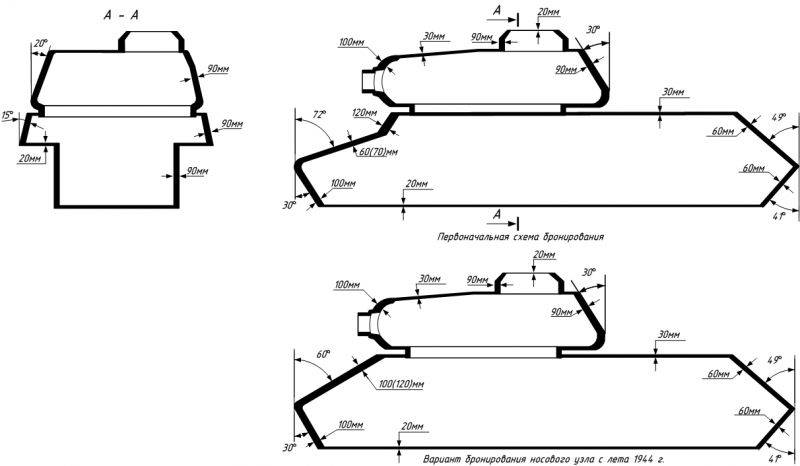

Information